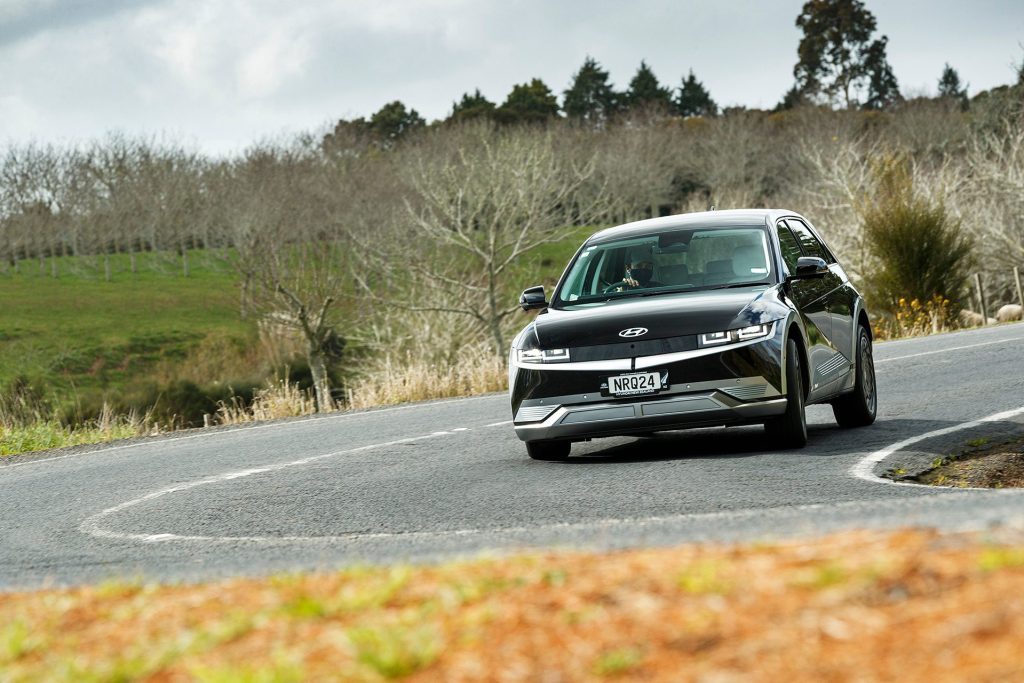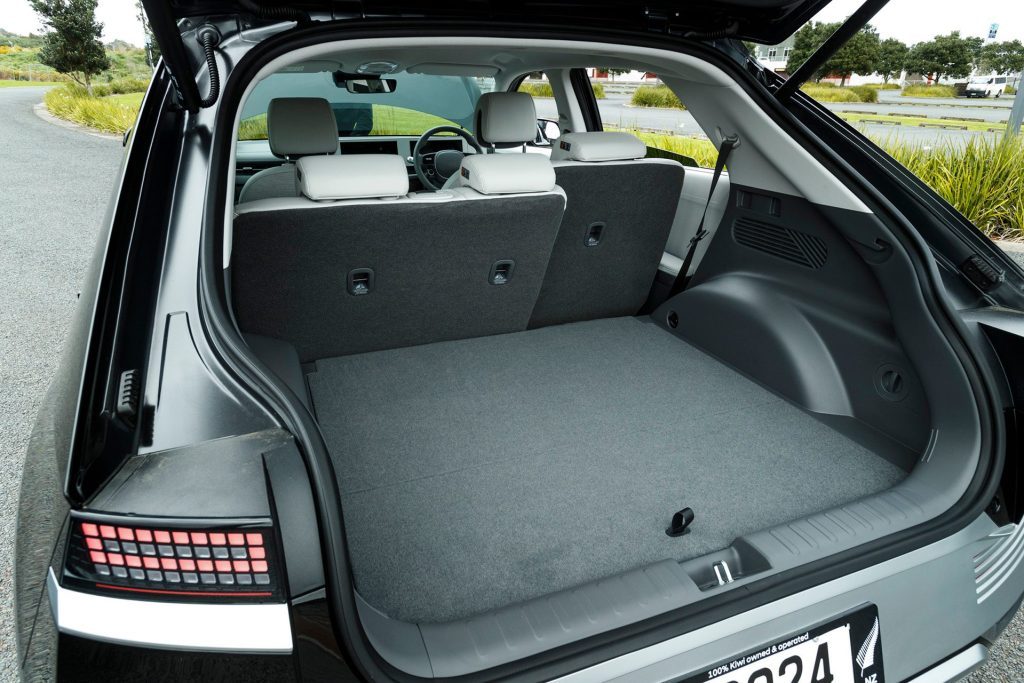2021 Hyundai Ioniq 5 72kWh Limited AWD review
Words: Kyle Cassidy | Photos: Tom Gasnier
The first of Hyundai’s Ioniq-branded EVs has arrived, model number 5. Is it a must-have?
Hyundai’s electric momentum continues with another battery-powered option in the new Ioniq 5. While many of its Japanese rivals are yet to fire an electric shot, the new 5 is Hyundai’s third EV. And more are on the way from the new Ioniq sub-brand, including a four-door and a large SUV.

But first we have the 5. This they like to call a midsize SUV but it’s essentially a big hatchback, a modern day Austin Maxi if you will, without all the oil leaks and breakdowns.
The look is fairly unique, said to be inspired by the original Pony car. No, not the Mustang but the Hyundai Pony. Can’t quite remember that? Yeah, me neither. But the 5’s clamshell bonnet and smooth, light intensive front end look good. The proportions aren’t elegant but they do give the 5 presence. Those into tech and things avantgarde should approve.

Better get the price out of the way early. The cheapest Ioniq 5, the only one up for the rebate (if they throw in the on-road costs) is the $79,990 58kWh model. This has a single rear-mounted 125kW/350Nm motor and a claimed 381km range. For reference, the base Model 3 is $68,732 including ORC and is rated at 448km.
The 72kWh Ioniq 5 is $89,990, gets a 160kW/350Nm motor and the bigger battery gives a 481km range, the best of the line-up. Next is the AWD version at $94,990 with 225kW and 605Nm from its twin motors. This should hit 100km/h in 5.2 seconds while range is rated at 460km. The 2WD 72kWh model is said to hit 100km/h in 7.4sec, and the 58kWh model in 8.5sec.

Meantime, the Elite 2WD is $96,990 (more spec) and the Limited AWD (even more stuff) is a whopping $109,990 (or $112,990 with the solar roof). Yep, that’s more than the Model 3 Performance. Tesla’s Model Y will be along eventually (no indicated price or timing just yet) while other would-be competitors include the Volkswagen ID.4, Kia EV6, Nissan Ariya, Subaru Solterra and Toyota bZ4X, all due at some stage. It’s a rapidly expanding area.
The Ioniq 5 has 800 volt charging capability so if you can find a 350kW charger, the battery can be replenished from ten to 80 per cent in a claimed 18 minutes! Hooking up to a 50kW charger for half an hour took the battery from 42 to 72 per cent, the range estimate lifting from 154 to 288km. There’s an 11kW on-board charger for faster AC wallbox filling (just under eight hours to charge a dead battery) but a three-pin plug takes forever (37 hours at 10A). So best buy a wallbox for home.

Consumption for this Limited AWD model is rated at 19kWh/100km (for a WLTP rated 430km range), while we managed an average of 21kWh/100km. It can be more economical however, particularly in city running. We noted that a few short trips (15km or so) averaged around the 13kWh/100km mark, according to the trip computer.
Your mileage will vary depending on many variables. One is how you use the brake regen strategy. By far the easiest is the one pedal mode, the go and whoa all controlled by the accelerator, the action of which is well tuned. And if you do need to brake, the transition from regen to the mechanical discs is all but undetectable, making for a smooth stop. There’s an Auto regen mode, which we didn’t get to terms with, instead opting to fiddle with the regen levels (four in total) ourselves via the wheel-mounted paddles. Set to zero (no regen), the 5 will coast when you’re up to speed and off the volts. And as we’ve said repeatedly, once in motion, an EV’s weight and minimal driveline friction see it roll a long way. Then you use the paddles to add regen braking. Get it right and you can bring the car to a complete stop by holding the left paddle. We noted better short term consumption figures using this method compared with the one-pedal mode, though it does require more thought. What is the point when you have such a big battery though? Well, the electricity needed for a recharge has to be generated somehow and so the less energy you use, the better off we will all be.

However, it can be hard to restrain yourself when you have the thrust of 605Nm, tapped immediately. While the 5 isn’t super quick, the way that torque hits in Sport mode (the power delivery is markedly different in the three drive modes) makes it comfortably fast enough in real world terms. Despite the outputs, it’s not a sports model. The steering assistance is good but the sensation is remote. There’s a degree of roll through the turns and while it resists understeer well the rear end can get a bit boisterous; the weight in the tail causes it to roll a little more than desired, the ESP having to sort things out. It deserves better damping too. The urban ride isn’t relaxed and could easily be more fluid. Then the 5 would be a big, effortless cruiser. The road noise is well muffled, and the motors aren’t too whiney. Despite the torque hit, the traction is well sorted, even when blasting out of intersections. And there is no delay when you mash the gas – you’ll always make that gap in the traffic. The turning circle isn’t the best at 12m, for which you can blame that long wheelbase.
The 5 sits on the firm’s Electric-Global Modular Platform, its key attribute being a long 3000mm wheelbase (longer than the Palisade’s even) to maximise the interior accommodations, or ‘the Living Space’ as they dub it.

While the front seats could do with more foam they are well shaped. When you’re waiting at the charger, these recline right back, sinking you down low while an abbreviated ottoman rises up just enough to support your legs as you stretch out. This luxury item is restricted to Limited buyers however.
The cabin feels spacious up front as there’s no console dividing the interior. And yet it also feels like a wasted space. But it has a (slightly odd) purpose, and that’s to allow easy movement between the front seats (“driver and passengers can freely enter and exit the cabin on either side when parked in a narrow spot…”).

The centre console, or Universal Island, has a large, open storage area that seems designed more with oversized handbags in mind but the drink holders are well sited, so too the charge pad and power sockets.
Its rear doors are large (good for entry but troublesome in tight parks), as is the accommodation in the back, with ample leg and head room. However, a third passenger here should either be small, or carried only occasionally. The boot is useful, though the high-set floor and sloping tailgate mean it’s smaller than you might expect. You can slide the back seat forward to make more room, and the split folding is quickly enacted. This EV can even tow, with a 1600kg braked rating.

There are dual 12-inch screens across the dash, one the digital cluster, the other the touchscreen infotainment, both with a degree of customisation.
The display has the usual EV-specific graphics to show charge and power flows, and the ever-present distance to empty. Screen layout changes with the drive modes, but is otherwise quite conventional in its design. The speed readout could be better positioned, as it can be obscured by the steering wheel. So too the drive selector, a stalk-mounted rocker, which is easy to operate but it’s mounted low behind the wheel and so not found as readily as it might be.

Not everything is mastered via the touchscreen, Hyundai retaining a few buttons (both hard and haptic) to execute things more simply.
This Limited gets the works, like the solar roof, recharging both the 12V and high voltage battery, (it has converted 19kWh of sunlight so far), and remote parking (you can summon the car out of a tight car park using the key fob), the lie-flat seats, powered rear sliding, heated seats, etc. All of Hyundai’s active safety systems are present too.
But it’s a high price this Limited asks, likely even more than the upcoming dual motor EQA 350. As such, it’s too pricey to recommend. It’s good, but not a game changer. We hope to drive the base model soon, which could be a different story.
| Model | Hyundai Ioniq 5 72kWh Ltd AWD |
| Price | $109,990 |
| Motor | dual, 225kW/605Nm |
| Battery | 77.4kWh (72.6kWh net) |
| Drivetrain | single-speed auto, AWD |
| Energy Use | 19.0kWh/100km |
| C02 Output | 0g/km |
| 0-100km/h | 5.2sec (claimed) |
| Weight | 2100kg (claimed) |












